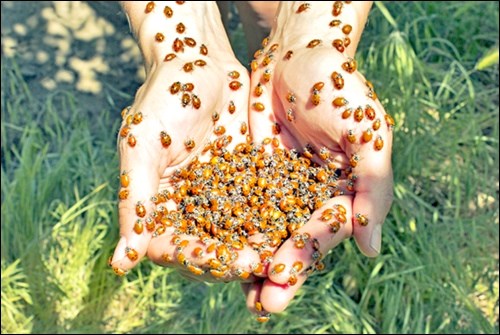As true winter approaches, we see changes in the insect population as those tiny and not so tiny critters prepare to survive another winter. Dave, the editor of Last Mountain Times, recently sent along an email and image of the explosion of his ladybug population. Strangely enough, I was at the time writing this article on how some of our tiny creatures prepare for the big deep freeze.
Many insects are much more visible in the fall as we have less time in the day when temperatures are warm, so when the sun beckons them to come out and soak up the rays they do so in droves. They will congregate wherever the sun shines and as the nights cool off they will do almost anything to find a bit of warmth. In fact, if you have any cracks or crevices into your warm house, they will gladly take that opportunity to enter.
As fall progresses, and we get a hint of winter those little critters seems to magically disappear. Strangely enough, months later like a magic trick gone bad, all of a sudden they are back. How can these amazing, but sometimes irritating, critters manage to survive the big freeze?
Insects have a variety of ways they can survive the winter so there is no simple answer to this question. Some will survive as eggs, larvae or pupae, which are all immature life forms or some, like the ladybug, will survive the winter as fully mature adults.
Avoiding the cold is one strategy that insects may take for winter survival. Take the monarch butterfly, who will fly thousands of miles to avoid the cold. Like our songbirds, once the cold begins to set in, they will head south en masse in order to avoid the cold. They will make a long journey to central Mexico while other butterflies like the Swallowtail will over winter as a chrysalis. Other insects will simply spend the winter at the bottom of ponds or buried deep in the soil to avoid the frost. Others, like some types of mosquitoes will hide out in sheltered places in a state of quiescence awaiting their next meal in spring. Some will enter into a semi-frozen state called diapause (or suspended animation) for the winter and in spring, thaw and crawl off as if winter had never happened. Thus, these critters have mystified scientists as these insects have found a way to freeze their organs and tissues and then spring back to life when the temperature rises.
Another huge number of insects will survive in the form of eggs. Thus in spring, a whole new generation will appear. When we have an unseasonably warm winter, it is an opportunity for a species to expand their territory in areas that they may not have been able to previously survive. For example, the mountain pine beetle has taken advantage of a few warmer winters moving further up and into cold areas. So far, the cold weather in the Rockies has stopped this invasive pest into eating eastern North America.
— Hanbidge is a horticulturist with the Saskatoon School of Horticulture and can be reached at 306-931-GROW(4769); by email at growyourfuture@gmail.com or check out our website at www.saskhort.com.



